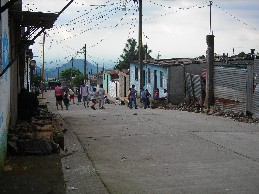
A few days ago, I returned to Canada after spending the greater part of 2007 in Guatemala, where I conducted my dissertation research on the subject of women and violence. More specifically, I was examining the impact of distinct and interrelated forms of violence on the everyday lives, practices, social relations and well-being of indigenous and ladina (non-indigenous) women in the departamento (province) of Guatemala. It was an election year, and from the moment of my arrival, I could sense the election process was going to set the tone for my stay and research. By the end of my visit, 53 political killings had been committed: the 2007 presidential elections were the most bloody in Guatemala’s recent history.
One of the presidential candidates, war-time army general Otto Pérez Molina, had proposed a mano dura, or “clenched fist”, approach to dealing with national problems of crime and insecurity. Though ultimately defeated by Alvaro Colom of the National Unity of Hope (UNE), the prospect of a victory by Pérez Molina and what it might mean—a return to the past, a return to a climate of terror, killings and impunity—caused palpable fear, particularly among sectors such as victims groups and human rights organizations. For some of the women in my study who had survived massacres and rape during the war, the impact of a win by Pérez Molina would have been devastating. They could not bear the sight of any soldier or armed man and trembled at even the thought.
While Molina’s defeat may be cause for relief, the election process brought to the surface the fragility of “peace” as Guatemalan society emerges from under the ashes of war. Over a decade after peace accords ended a 36-year internal conflict, Guatemala continues to be plagued by human rights violations, as well as everyday crime and violence. Guatemala currently faces climbing homicide rates, particularly murders of women, youth and children, escalating gang activity, organized crime and narcotrafficking, high rates of firearm possession and use, and a high incidence of armed robberies and theft. These problems are compounded by the extreme poverty and hunger, unemployment, illiteracy, dense housing settlements, and lack of potable water confronted by large segments of the population.
In this context of past and present violence, I was interested in how women establish a sense of the ordinary—how violence, and fear of violence, affected how women saw themselves, shaped their daily decisions and practices, and influenced their social and personal relationships.
My study included a broad sample of participants. Contacts made during previous research in Guatemala provided subjects for my initial interviews. Later, I met others through institutions dedicated to reducing gender-based violence, such as Fundación Sobrevivientes and Grupo Guatemalteco de Mujeres. During my first few months in the country, I sat in on the meetings of a Guatemala City based support group for female survivors of violence. Participants included victims of domestic abuse and sexual assault, as well as the relatives of murdered women. I later visited a number of these women in their homes to explore further some of the issues discussed in the support group. Additional perspectives came from interviews with professionals providing services to women in situations of violence. I also made efforts to include the voices of women not aligned to any particular institution. In the last weeks of my research, I accompanied a group of psychology students from the Centre for Psychosocial Assistance to Victims of Political Violence (CAPVVIPO, based out of the University of San Carlos, to a community composed of individuals among the 1.5 million internally displaced during the war. There, I collected further life histories and interviews.
These conversations made evident the different forms of violence intersecting and jointly manifesting themselves in women’s everyday lives. Not only are women faced with the residues of war-time violence, but they must also live with present-day insecurity and impunity, where basic economic survival is a struggle. Beyond the femicidal killings, sexual assaults and domestic violence so rampant in the country, generalized insecurity affects women going about their daily lives, particularly in the capital city where I conducted my research, and creates its own intrusive set of fears: Will my children return home safely? Will my bus ride to work be interrupted by an assault?
The women I met shared difficult life stories, ones marked by hardship. But as much as their stories describe adversity, they are also stories of struggle, survival and resilience. They are stories of extraordinary strength, inspired by their children, memories of deceased loved ones, work or community involvement, which provide them with a sense of meaning and a reason for going on— fuerzas para de salir adelante. Guatemala's women have great hopes and dreams for their and their children’s futures. I look forward to returning and seeing these hopes and dreams brought to fruition.
Toronto, December 2007